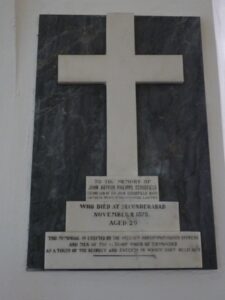Burton is a small village which sits on the bank of the River Cleddau in Pembrokeshire, about three miles east of Milford Haven and about three miles north of Pembroke, which is on the opposite side of the Haven. The parish church, which is dedicated to St Mary, contains two brass plaques which commemorate the fallen parishioners of both world wars, as well as a small number of individual memorials, including a fine leaded window. Photographs of these memorials were kindly supplied to the website by Mike Berrell.
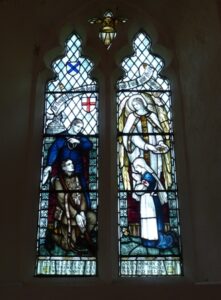
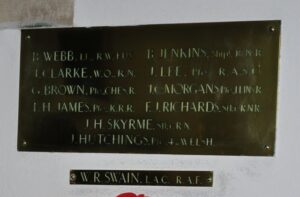
The Great War, 1914-1918
George Brown, Private, 18099, Cheshire Regiment. George was the son of Edward and Mary Brown, of Houghton, Burton. He had been a Missioner at Aberdare prior to the war, and enlisted there into the army, being posted to the 1st Battalion, Cheshire Regiment. The battalion moved to France on 15 August 1914, attached to 15 Brigade, 5th Division, and fought at the Battle of Mons, and the retreat south. They saw further action at Le Cateau, and took part in the retreat to the Marne where the German attack was halted. They took part in the advance to the Aisne, before moving to Flanders, where they fought at the Battle of La Bassée, then at Messines in October, 1914. They fought here through First Ypres, and took part in the capture of Hill 60, and then fought at Second Ypres in April 1915. George was killed in action at Ypres on 1 June 1915. He was 37 years old, and is commemorated on the Ypres (Menin Gate) Memorial, Belgium.
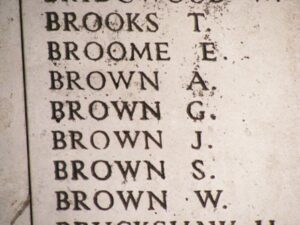
James Benjamin Clarke, Carpenter, Royal Navy. James was the son of John and Florence Clarke, of Ashdale, Burton. He was a pre-war regular in the Royal Navy, serving as a Carpenter aboard HMS Cressy, which was an armoured cruiser, attached to the 7th Cruiser Squadron. Shortly after the outbreak of war, the 7th Cruiser Squadron was formed to patrol the North Sea, in support of a force of destroyers and submarines based at Harwich, which blocked the Eastern end of the English Channel from German warships attempting to attack the supply route between England and France. On 22 September 1914 Cressy was sunk by two torpedoes from the German U-boat U-9 while attempting to rescue survivors from her sister ships Aboukir and Hogue, who had been sunk minutes earlier. James was killed in the sinking of Cressy. He was 29 years old, and is commemorated on the Chatham Naval Memorial, Kent.
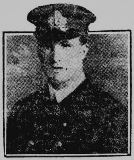
George Thomas Freeman, Sergeant, 55996, Northumberland Fusiliers. George was the son of William Henry and Ann Mary Freeman, of Woodstock, Oxfordshire. He married Mary Ann Bilson, of Burton prior to the war, and the couple set up home at High Street, Lower Wolvercote, Oxon. George enlisted at Abingdon into the army, and was posted to the 20th (Tyneside Scottish) Battalion, Northumberland Fusiliers, which was attached to 102 Brigade, 34th Division, and landed in France in January 1916. It saw its first major action on the Somme, during the Battle of Albert, where it suffered very severe casualties during its part in the attack on La Boiselle. It then took part in the Battle of Bazentin, Battle of Pozieres and the Battle of Flers-Courcelette. The following year saw them fighting at Arras, during the First and Second Battles of the Scarpe, and the Battle of Arleux. George was wounded later that year, and died in hospital at Etaples on 8 November 1917, aged 32. He is buried in Etaples Military Cemetery, France. George is not commemorated at Burton.
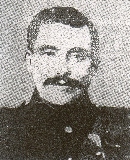
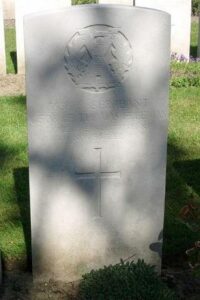
Gerard Younghusband Harrison, Sub Lieutenant, Royal Navy. Gerard was born at Burton Rectory on 24 February 1897, the son of Reverend Arthur Leonard Harrison, and of Ethel Harrison. By 1901 the family had moved to Suffolk, and sometime prior to the war were residing at Elysium, Framingham Pigot, Norwich. Gerard enlisted into the Royal Navy, and after training, was serving as Sub-Lieutenant aboard HMS Vanguard. Vanguard was a modern St. Vincent Class Battleship, and had taken part in the Battle of Jutland on 31 May 1916. Just before midnight, on 9 July 1917, Vanguard was at anchor in Scapa Flow, when a massive explosion ripped through her magazines, tearing the ship apart and sending her to the bottom of Scapa Flow, with the loss of all but two hands. Gerard was just 20 years old when he died during the explosion, and is commemorated on the Chatham Naval Memorial, Kent. His brother, Leonard, had been killed just two years earlier. Neither Gerard nor Leonard are commemorated on the Burton War Memorial.
Leonard John Harrison, Lieutenant, Lancashire Fusiliers. Leonard was born at Burton rectory on 21 November 1895, the son of Reverend Arthur Leonard Harrison, and of Ethel Harrison. The family had moved to Sussex by 1901, and sometime prior to the war had moved to Elysium, Framingham Pigot, Norwich. Leonard had been educated at Haileybury College, from where he passed into the Royal Military College, Sandhurst, in December 1912. Leonard was commissioned into the Indian Army in August 1914, but as war erupted, he was posted to the 2nd Battalion, Lancashire Fusiliers, joining them in France on 16 February 1915. The battalion was at Ypres, attached to 12 Brigade, 4th Division. On 24 May 1915, Leonard led his Platoon in an attack to regain some trenches near Mouse Trap Farm. He was killed in the middle of No Mans Land, and his body was never recovered for burial. Leonard was just 19 years old, and is commemorated on the Ypres (Menin Gate) Memorial, Belgium. His brother, Gerard, was killed two years later. Neither Leonard nor Gerard are commemorated on the Burton War Memorial. A third brother, Alick Robert Walsham Harrison was too young to fight in the war, becoming Warden of Merton College, Oxford in later life.
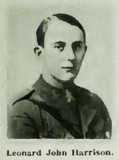
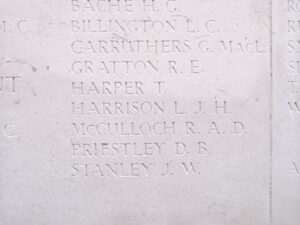
John Hutchings, Private, 201971, Welsh Regiment. John was born at Llangwm. He enlisted at Pembroke Dock into the Welsh Regiment, and was posted to the 18th Battalion, which was attached to 119 Brigade, 40th (Bantam) Division. This Division was formed between September and December 1915, composed of bantam units and others which had a mixture of regulation-height and shorter men. Weeding out of very under-sized or unfit men delayed the training programme, and it was not until late spring 1916 that the Division was ready to proceed on active service. The Division moved to France between 1-9 June, and moved to the front near Loos. Late in 1916 they moved south to the Somme, and fought at the Battle of the Ancre, and remained in the area over the winter. In March, 1917 the Germans withdrew to their shortened line, called the Hindenburg Line, and the 40th Division were one of the Divisions that followed the withdrawal. Later in the year they took part in the Battle of Cambrai, playing an important role in the attack on Bourlon Wood. John was killed in action at Bourlon Wood on 24 November 1917. He is commemorated on the Cambrai Memorial, Louverval, France.
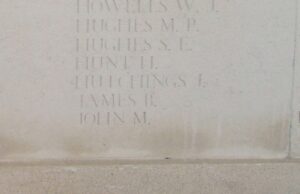
Thomas Henry James, Rifleman, A/186, Kings Royal Rifle Corps. Thomas was the son of John James, of Houghton Post Office, Neyland. He enlisted at Llanelli into the army, and was posted to the 8th Battalion, King’s Royal Rifle Corps, which was attached to 41 Brigade, 14th (Light) Division, and landed in France in May 1915. The Division took up positions east of Ypres, on the Menin Road at Hooge. On 30 July 1915 the Germans launched an attack on the 14th Division at Hooge, using their new invention of the flammenwerfer, or flame-thrower. Fierce hand to hand combat followed, and 41 Brigade lost all of their front line positions after suffering terrible losses. Thomas was wounded during this terrible fighting, and died of his wounds on 5 August 1915, aged 20. His grave was lost during further fighting in the area, and Thomas is now commemorated on the Ypres (Menin Gate) Memorial, Belgium.
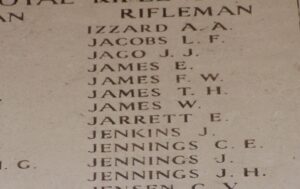
Bertie Jenkins, M22936, Royal Navy, HMS Victory II. Bertram (Bertie) was born on 15 August 1895, the son of William and Anne Jenkins, of Guildford, Burton. Bertie and his father worked at Pembroke Dockyard prior to the war, and on 19 September 1916, Bertie enlisted into the Royal Navy. After training at HMS Victory, in Portsmouth, Bertie was posted to HMS Amphitrite. HMS Amphitrite was a Diadem-class Cruisers, which had been built at Vickers Limited, Barrow in Furness and launched on 5 January 1898. At the outbreak of was she was part of the Ninth Cruiser Squadron, serving in the Atlantic. In June 1915 she was placed in reserve, but reactivated as a minelayer in 1917, which is when Bertie joined her crew. Bertie took ill with chronic bronchitis while serving aboard Amphritrite, and was hospitalised at Portsmouth. He was discharged on 14 February 1918, but died at 24, Prospect Place, Pembroke Dock of Bronchitis on 5 May 1918, aged 21. Bertie was accepted for commemoration by the CWGC on 6 April 2012. The location of his grave has not been verified, so Bertie will be commemorated on the Addenda Panel of the Portsmouth Naval Memorial, Hampshire.
James Lee, Private, Royal Army Service Corps. Very little is known of James except that he served with the Royal Army Service Corps. Nothing further can be traced of him.
James Clifford Morgan, Private, 20049, Leinster Regiment. James was the son of W. H. and Annie Morgan, of Mayfield House, Burton. He enlisted at Haverfordwest into the Pembroke Yeomanry, but was later transferred to the 2nd Battalion, Leinster Regiment, which was attached to 88 Brigade, 29th Division. The Division had forged a reputation fighting at Gallipoli in 1915, before moving to the Western Front, where it suffered heavy losses in the Somme Battles. In the Spring of 1917 they fought at the Battle of the Scarpe, which was part of the Arras Offensive, and then moved further north to Ypres. Here they fought at the Battle of Langemarck, and then at the Battles of the Menin Road, Polygon Wood, Broodseinde and Poelcappelle, before moving to Cambrai. Here they fought at the Battle of Cambrai in November and December, 1917 before moving back to Flanders early in 1918. The German Spring Offensive hit the British on the Somme on 21 March, 1918, and hit in Flanders just weeks later. The 29th Division fought at the desperate defensive battles of the Lys. James was wounded during the offensive in Flanders in August 1918. He was evacuated to the Hospital at St. Omer where he died of his wounds on 6 September 1918. James was 25 years old, and is buried at Longuenesse (St. Omer) Souvenir Cemetery, France.
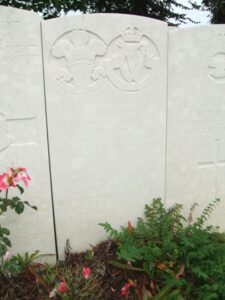
Frederick James Richards, Stoker, 5502S, Royal Naval Reserve. Frederick was the son of William and Fannie Richards (nee Barrah), of Dumpledale, Burton, and served in the Royal Navy aboard HMS Warrior. Warrior was a Duke of Edinburgh Class Armoured Cruiser, and was built at Pembroke Dockyards, and launched in 1905. She became part of the 1st Cruiser Squadron in December 1914. At the Battle of Jutland on 31 May 1916, she came under fire from German battleships while attacking light cruisers, and was badly damaged by gunfire, which caused large fires to break out and heavy flooding. She limped away from the battle area under her own power, and was then taken in tow by the seaplane tender HMS Engadine who took off her surviving crew of 743. She was abandoned in a rising sea at 08.25 on 1 June, and foundered and sank. Frederick was one of around fifty men who died aboard Warrior during the Battle of Jutland, on 31 May 1916. He was 20 years old, and is commemorated on the Plymouth Naval Memorial, Devon.
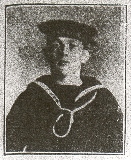
James Henry Skyrme, Stoker 1st Class, 296150, Royal Navy. James was the son of William and Jane Skyrme, of Williamston Terrace, Guildford, Llangwm. He served as a pre-war regular in the Royal Navy, aboard HMS Amphion. Amphion was a new scout cruiser, and was stationed in the English Channel. In the afternoon of 6 August 1914, Amphion was patrolling in the Channel when she struck a mine which had been laid earlier that day by a German minelayer. She blew up and sank almost immediately, with the loss of 150 lives. Among the dead was James Skyrme. He was 33 years old, and is commemorated on the Plymouth Naval Memorial, Devon. Amphion was the first Royal Naval ship to be sunk in the course of the Great War.
Joseph Gilbert Webb, MC, Lieutenant, Royal Welsh Fusiliers. Joseph was the Husband of Elizabeth Webb, of Bulmer House, Haverfordwest. He had been commissioned into the Royal Welsh Fusiliers, and served with the 14th Battalion, attached to 113 Brigade, 38th (Welsh) Division. The Division landed in France during December 1915 and had spent their first winter in the trenches near Armentieres. In June they marched south to the Somme, where they were tasked with the capture of Mametz Wood. The attack on the wood began on 7 July, but met with fierce resistance, and it took until 14 July to totally clear the wood. The Division suffered terrible casualties at Mametz, and were taken out of the line, and moved to Ypres to rebuild. Here they fought at the Battle of Pilckem Ridge, and the Battle of Langemarck. They then moved to Armentieres, where they remained from September 1917 until March, 1918 when the German Spring Offensive was launched. The British had been over-run on the Somme, and so in April the Division was moved South, taking up positions North of Albert, from where they weathered the storm of the coming months. Joseph was wounded at some stage in early 1918, and evacuated to a Hospital in Britain for treatment, but sadly died of wounds on 9 May 1918. He is buried at St. Thomas A Beckett Churchyard, Haverfordwest. Joseph was awarded the Military Cross for the action in which he was wounded. The award was published in the London Gazette of 2 July 1918, and read; ‘For conspicuous gallantry and devotion to duty when in command of a fighting patrol of 8 men. Being attacked by an enemy patrol of 28 men, he at once opened fire and charged the enemy. He drove them back in confusion, inflicted heavy casualties on them, and captured two prisoners. All his patrol, including 3 wounded men, were brought back safely.’
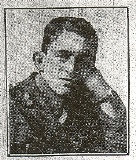
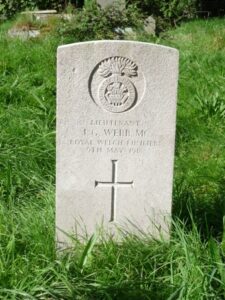
World War Two, 1939-1945
William Richard Swain, Leading Aircraftman, 1421534, Royal Air Force Volunteer Reserve. William was the son of Richard and Mary Swain, of Burton. He married prior to the war, and resided with his wife, Edith Mary Swain, at Houghton. William served with the Royal Air Force during the war. Nothing is known of his service, but he died in Pembrokeshire on 11 July 1944, aged 42, and is buried at Burton (St. Mary In Rhos) Churchyard.
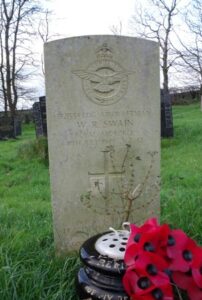
There is also a memorial within the Church which commemorates the memory of Captain John Arthur Philipps Scourfield, of the XII Prince of Wales’s Royal Lancers, who died of his wounds at Secunderabad on 11 November 1878, aged 29. John was the son of Sir John Scourfield. His brother Owen Scourfield was the Lord Lieutenant of Carmarthenshire. The family seat was at Williamston, Burton.
